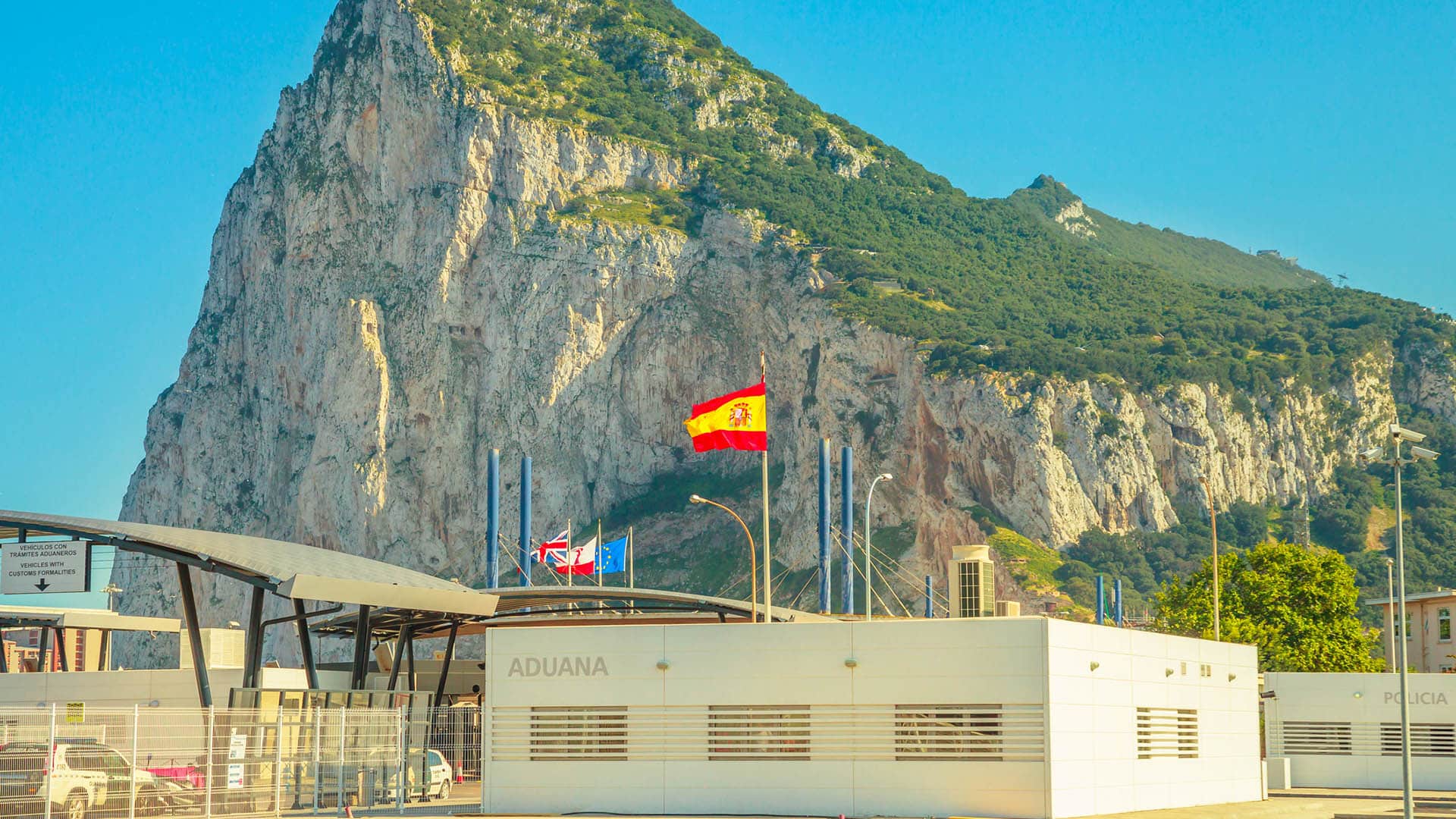Spain and the UK have finally put their relationship on a new and bolder footing, following June’s agreement on Gibraltar, a British Overseas Territory, which removes border checks between Spain and the Rock.
The UK-EU agreement on Gibraltar, ceded to Britain under the 1713 Treaty of Utrecht and long claimed by Spain, was the last piece of the UK’s EU exit jigsaw, enabling the two countries to deepen their relationship. In the 2016 referendum an overwhelming 96% of Gibraltarians voted in favour of remaining in the EU. At Spain’s insistence, Gibraltar was not covered by the Trade and Cooperation Agreement (TCA), which sets out post-Brexit arrangements for the UK and came into force in May 2021 (see Figure 1).
Figure 1. EU-UK relations: big changes compared with benefits of EU membership
| EU-UK Trade and Cooperation Agreement | EU Member State | |
|---|---|---|
| Free movement of people | ||
| Removal of border checks | No | Yes |
| Pet passports | No | Yes |
| Visa-free travel (90 days in 180-day period) | Yes | Yes |
| Visa-free travel (beyond 90 days) | No | Yes |
| Right to work, study, live in another EU country | 0 | Yes |
| Removal of roaming charges | No | Yes |
| Trade in goods | ||
| Frictionless trade | No | Yes |
| Zero tariffs or quotas | Yes | Yes |
| Zero customs formalities | 0 | Yes |
| Zero sanitary and phytosanitary (SPS) checks | No | Yes |
| Zero rules of origin procedures | 0 | Yes |
| Fisheries agreement | Yes (with conditions) | Yes |
| Trade in services | ||
| Financial services passport | No | Yes |
| Easy recognition of professional qualifications | No | Yes |
| Air transport | ||
| Single aviation area, full freedoms | No | Yes |
| Bilateral 5th freedoms for extra-EU air cargo | Yes (limited) | Yes |
| Road transport | ||
| Single internal transport market for hauliers | No | Yes |
| Cross-trade operations | Yes (limited) | Yes |
| Energy | ||
| Single internal energy market | No | Yes |
| Energy trading platforms | Yes (limited) | Yes |
| EU programmes | ||
| Access to Erasmus | No | Yes |
| Access to NextGeneration EU, SURE | No | Yes |
| Galileo encrypted military signal | No | Yes |
| Access to Horizon Europe | Yes (from January 2024) | Yes |
The Gibraltar agreement was signed after three and a half years of negotiations, longer than it took for the UK’s withdrawal agreement from the EU and the subsequent TCA. The price, among other factors, of an open land crossing into Spain is dual Gibraltar and Schengen border checks at Gibraltar’s airport. Spain will carry out the Schengen checks. The treaty has yet to be ratified by the EU and British parliaments. Once this is done the 1.2km border fence between Spain and Gibraltar will be removed. Around 15,000 frontier workers residing in Spain (over half of Gibraltar’s workforce) cross the border every day. The dictator, General Franco, closed the border in 1969 and it was not fully reopened until 1985, the year before Spain joined the EEC.
The imminence of the EU’s new Entry/Exit System for non-EU citizens, which is being phased-in between this month and next April, brought greater urgency to reaching agreement on the EU-Gibraltar treaty before the EES was launched. Without the agreement the new automated IT system for registering travellers might have introduced a hard border between Spain and Gibraltar unless there were other arrangements. That would have meant checking everyone’s documents, creating long queues. David Lammy, the former British Foreign Secretary, said this would ‘wreck the territory’s economy and possibly cost it hundreds of millions of pounds a year’.
Instead, although Gibraltar is not joining the Schengen area, which has no internal border checks on the movement of people, once the treaty is implemented the infrastructure currently at the land border, including for the EES, will be moved to the airport, while the 1.2km fence between Gibraltar and Spain will be removed.
The Spain-UK strategic framework signed last month enhances bilateral cooperation ‘in full coherence and complementarity with Spain’s membership of the EU and with the relationship the UK has established with the EU through existing agreements and arrangements and others that may be concluded in the future’.
Of the four large EU economies, Spain was the only one without a bilateral agreement with the UK, putting both countries at a disadvantage. France has the 2010 Lancaster House Treaties and the 2025 Lancaster House 2.0, Germany the 2025 treaty and Italy the 2023 memorandum of understanding on bilateral cooperation.
That gap has now been filled and a roadmap for greater cooperation created. The framework is long on good intentions and short on specifics but should enable the already thriving trade and investment relationship to flourish further. There are now channels at a higher political level for resolving problems, such as improving short-term business travel stays, and cooperating on issues, with provision for an annual dialogue between the two countries’ Foreign Ministers.
Both sides would like greater mobility opportunities (temporary movement not migration) and are committed to working towards a youth experience scheme between the UK and the EU. Exchanges under the Erasmus student mobility programme were highly popular between the UK and Spain, but when the UK left the EU it opted not to take part in the Erasmus+ programme 2021-27 as an associated third country. Spain was a top receiving country for UK students and Britain was the second most popular destination for Spaniards.
The Spanish and UK governments are to some extent politically aligned; both are led by social-democratic parties. Spain’s government, however, is a minority coalition with the hard-left Sumar with unreliable parliamentary support from an unholy alliance of Catalan and Basque separatist and nationalist parties. The UK’s Labour government, on the other hand, enjoys a whopping parliamentary majority.
Spain recognised a Palestine state in May 2024 and the UK in September 2025. Prime Minister Pedro Sánchez is the most vocal critic in Europe of the Israeli government’s ‘genocide’ in Gaza, a term that Prime Minister Sir Keir Starmer has not used. Sánchez has also announced plans to formalise an arms embargo and block Israel-bound fuel deliveries from passing through Spanish ports. The UK does not have a full arms embargo; most significantly, it supplies 13% to 15% of the components used in the F-35 jet, used extensively by Israel to strike Gaza. These components are sent to manufacturing centres abroad as part of a global programme.
Both Sánchez and Starmer are also at the forefront of Europe’s support for Ukraine against Russia’s war of aggression.
Total trade in goods and services (exports and imports) between Spain and the UK in 2024 amounted to €69.5 billion, making Spain the UK’s 7th largest trading partner, while the UK is Spain’s 5th largest. Spain has run a merchandise trade surplus with the UK for many years (see Figure 2).
Figure 2. Spain’s merchandise exports to the UK and imports from the UK, 2000-24 (€ billion)
| 2000 | 2005 | 2010 | 2016 | 2019 | 2024 | |
|---|---|---|---|---|---|---|
| Exports | 10.2 | 13.0 | 11.5 | 19.1 | 19.7 | 23.8 |
| Imports | 12.0 | 13.2 | 10.9 | 11.2 | 11.9 | 10.2 |
| Balance | -1.8 | -0.2 | +0.6 | +7.9 | +7.8 | +13.6 |
The EU and the UK are working on a sanitary and phytosanitary (SPS) agreement which would simplify the movement of food and agricultural products by slashing costs, reducing border checks and eliminating paperwork like export health certificates for many products. Both Spain and the UK would benefit significantly from an agreement. The EU and the UK are also looking to link their emissions trading schemes, which would benefit Spain’s steel and chemical industries.
The UK’s rejoining in 2024 of Horizon Europe, the EU’s key funding programme for research and innovation, as an associated country is spurring cooperation links between Spain and Britain. Spain is second after Germany in terms of links (close to 1,500 projects involving British and Spanish institutions, 9.3% of the total). Spain is the UK’s top collaborator for Horizon pillar 2 (global challenges/European industrial competitiveness).
As regards direct investment, the UK’s stock in Spain stood at €68.5 billion at the end of 2023, more than Italy and France and not far behind Germany (see Figure 3). Spain’s stock in the UK was £16.1 billion, substantially lower than in 2019 (see Figure 4). The last significant Spanish investment in the UK was state-owned shipbuilder Navantia’s purchase this year of Harland & Wolff’s facilities in Belfast, Appledore, Methil and Arnish, after it fell into administration in 2024. As the historic Titanic shipyard in Belfast is still undergoing upgrades, a UK warship will now be largely built in Spain.
Figure 3. Main investor countries in Spain, stock of inward direct investment, (€ billion) (1)
| 2014 | 2019 | 2023 | |
|---|---|---|---|
| US | 52.4 | 87.5 | 117.1 |
| Italy | 43.9 | 38.5 | 48.3 |
| UK | 43.8 | 66.9 | 68.5 |
| France | 39.3 | 54.5 | 68.8 |
| Germany | 30.7 | 44.9 | 72.0 |
| Mexico | 23.6 | 87.5 | 32.3 |
Figure 4. Main investor countries in the UK, stock of inward direct investment, (£ billion)
| 2014 | 2019 | 2023 | |
|---|---|---|---|
| US | 242.0 | 460.0 | 692.9 |
| Netherlands | 180.2 | 168.4 | 183.0 |
| France | 75.8 | 75.1 | 115.6 |
| Germany | 51.0 | 44.0 | 41.6 |
| Luxembourg | 71.8 | 149.9 | 185.6 |
| Spain | 43.0 | 44.9 | 16.1 |
In defence, if there is an agreement on the UK’s participation in Security Action for Europe (SAFE), a new financial instrument designed to support joint procurement and investment in European defence production, Britain and Spain will seek opportunities to cooperate.
As well as the trade and investment relationship, there is the ‘people’ relationship. Spain is the top spot in the world for British holidaymakers (18.4 million tourists in 2024, see Figure 5).
Figure 5. International tourists coming to Spain by country of residence, 2024 (million)
| Million | % of total tourists | |
|---|---|---|
| UK | 18.4 | 19.6 |
| France | 12.9 | 13.7 |
| Germany | 11.9 | 12.6 |
| Italy | 5.4 | 5.7 |
| Nordic countries (1) | 5.1 | 5.4 |
| Netherlands | 4.7 | 5.0 |
| US | 4.2 | 4.5 |
The resident British community in Spain, based on those registered in town halls, was the sixth largest at 272,402 at the end of 2023 and the largest located in all of Europe (see Figure 6). A more realistic figure, according to the Ministry of Inclusion, Social Security and Migration and based on those with their residency document in order, was 425,770 at the end of June. The large difference is due to various factors including people signing up to the municipal register (padrón), not keeping their record up to date and then falling off the register. Not all those with the residency document live permanently in Spain.
Figure 6. Ten largest foreign nationalities at 1 January 2024 and 1 January 1996 (1)
| Number in 2024 | % of total | Number in 1996 | % of total | |
|---|---|---|---|---|
| Morocco | 920,693 | 14.2 | 111,043 | 17.4 |
| Romania | 620,463 | 9.5 | 2,258 | 0.3 |
| Colombia | 578,477 | 8.9 | 9,997 | 1.6 |
| Italy | 325,358 | 5.0 | 19,287 | 3.0 |
| Venezuela | 325,254 | 5.0 | 16,549 (2) | NA |
| UK | 272,402 | 4.2 | 75,600 | 11.8 |
| China | 226,718 | 3.5 | 11,611 | 1.8 |
| Peru | 219,643 | 3.4 | 928 (2) | NA |
| Ukraine | 210,012 | 3.2 | 727 (2) | NA |
| Honduras | 171,771 | 2.6 | 795 (2) | NA |
| Total of all nationalities | 6,502,282 | 100.0 | 637,085 | 100.0 |
The rules for Brits wishing to begin to live in Spain after Brexit, as opposed to those already in the country with legal residence before Brexit, are now the same as those for citizens of any other non-EU country. The maximum length of a short-term stay for non-EU citizens in the entire Schengen area is 90 days within any 180-day period unless a long-stay visa is obtained. It is now more difficult to live under the radar.
The number of Spaniards with settled status at the end of June was 340,791, according to the Home Office (see Figure 7). Many status holders, however, might not have lived in the UK for many years, or visited the country. Also, many might have spent time in the UK in the 2010s and then applied for EUSS status after Brexit just in case they wanted to come back to the UK.
Figure 7. Concluded applications to the EU settlement scheme by nationality and outcome, 28 August 2018-30 June 2025, UK total
| Total applications, settled and pre-settled status (1) | Approved settled status (2) | |
|---|---|---|
| Romania | 1,864,312 | 1,053,974 |
| Poland | 1,272,760 | 1,077,910 |
| Italy | 739,696 | 515,858 |
| Bulgaria | 511,717 | 305,315 |
| Spain | 482,627 | 340,791 |
The UK-Spain framework should enable the business communities of both countries to move on from Brexit. Spain, for its own historic reasons and the profound change EU membership has brought, is highly unlikely to leave the bloc and there is little prospect, as things stand at the moment, of the UK rejoining.



